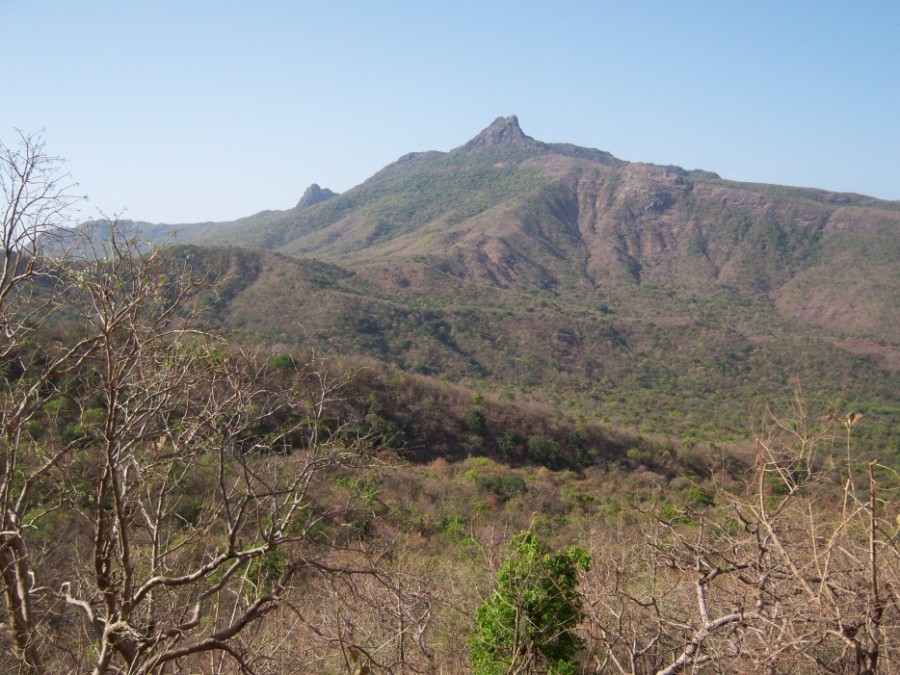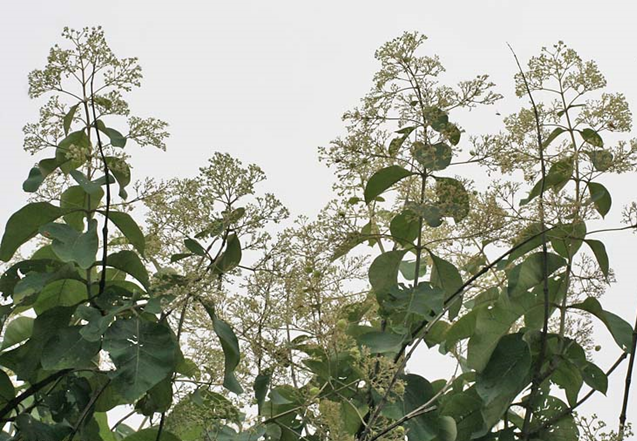Chapter outline and page reference:
Introduction 120
Brief Description of the Girnar Forest 122
Vegetation Types at Girnar 128
History of Management of the Girnar Forests 133
Medicinal Plants at Girnar 148
Girnar Plants as Mentioned in the Vishnu Parva of the Harivamsa 154
Girnar Plants as Mentioned in the Skand Puran 157
Girnar Plants as Mentioned in the Markandey Puran 159
Girnar Plants as Mentioned in the Mirat-i-Sikandari 161
Heritage Trees of Junagadh 162
Plants of Sakkarbagh Zoo, Junagadh 164
Tree Cover in Junagadh Municipal Corporation 164
Some Cryptogams of Girnar 165
Some Fungi of Girnar 167
The Forests of Gir 167
Chapter preview (first three pages only):
Figure 32. The Girnar Forest (photo by Wainer 2008).
Introduction
The Girnar Forest was categorized as a Rich Biodiversity Area, one of eight within Gujarat (Pilo et al 1996). It was declared as Reserved Forest under the State Act of the ex Junagadh State in 1908. Subsequent to the merger of the area in the Indian Union, provision of the Act was made applicable to it, and it was declared under section 4 of the Indian Forest Act 1927. The Girnar Forest was declared as a Wildlife Sanctuary by the Notification of Government (GNV-2008-(28) VPS-10227-2069-W (5071)) on the 31st May 2008 (Khanna 2011, page 45).
Menon and Shah (1982b) referred to four major forest divisions of Saurashtra, namely Gir, Girnar, Bhavnagar and Rajkot-Jamnagar. Meher-Homji (1975) noted that: ‘The forests of Gir, Girnar, Alech and Barda in the hilly region of Kathiawar which occur as islands in the Acacia-Capparis thicket type of vegetation are…rich in the Indian-Indo-Malayan elements.’
The Vastrapatha Ksetra Mahatmya (11th–12th century AD) provides specific mention of 73 separate kinds of plants, mostly trees, at Girnar. These are listed at the end of this chapter. A list of 828 species of vascular plants (native, naturalised and cultivated) found in the Girnar area, based on various sources, is presented in Appendix 1. Lists of plants recorded from Junagadh by Santapau (1962), Bole and Pathak (1988a,b), Ahluwalia (1967) and Mankad, Jadeja and Odedra (2007) are presented in Appendix 2. A list of plants found in the Gir Forests, provided by the Forest Department, Sardarbagh, Junagadh, enumerates a total of 606 species. A study by Pandit (2003) found in the Gir Forest a total of 431 species of plants. Singh et al (2002) recorded 759 plant species (515 indigenous and 244 introduced species) from the Barda Wildlife Sanctuary, about 50 km north-west of Girnar, and Nagar (2005) recorded a total of 907 species from Barda Hills and surroundings.
It is worthy of note that Girnar is also the Hindi name of an Indian plant, Dillenia indica L. (synonym D. speciosa Thunb., Family: Dilleniaceae), which apparently does not occur at Mount Girnar. Its English common names include elephant apple, Indian catmon, and hondapara tree, it grows to a tall evergreen tree, and it has fragrant large white flowers and edible fruit.
Figure 33. Flowers and leaves of teak (Tectona grandis).
Brief Description of the Girnar Forest
Joshi et al (1988, page 9) briefly defined the vegetation formation at Girnar: ‘Technically the Girnar forest is described as “Type VII-A/c-1 Southern Tropical Dry Deciduous, Dry Teak Forest”. It is divided into three parts such as (a) the Teak forest, largely found on the foothills adjoining the plains and on the lower slopes of Girnar, covers more than half of the entire forest; (b) the miscellaneous forests found in the eastern outer periphery of Girnar and (c) scrub forest found in all the degraded patches in the plain area as well as on the hill tops along the ridges of Girnar.’
A clarification of the above designation is that the Tropical Dry Deciduous Forests fall in ‘Group 5’ of ‘Major Group II – Dry Tropical Forests’, and the Southern Tropical Dry Deciduous Forests therefore belong to Sub-group 5A. This sub-group is further divided into three, the first of which is ‘C1 dry teak-bearing forest’, which is again divided into ‘1a very dry teak forest’ and ‘1b dry teak forest’ (Champion and Seth 1968, also see Gupta 2011, page 89). Dixit et al (2001) described Girnar as a ‘Very Dry Deciduous (Teak) Forest’, and Khanna et al (2011, page 20) referred to it as ‘Very Dry Teak Forest’ according to the Champion-Seth revised classification.
Champion and Seth (1968, page 45) defined dry deciduous forests as: ‘entirely deciduous or nearly so. Top canopy rather light and rarely over 25 m. high,

